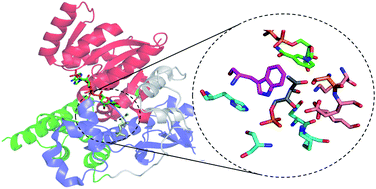The MEP pathway and the development of inhibitors as potential anti-infective agents†
Abstract
The non-mevalonate (or MEP) pathway represents an essential biosynthetic route used by plants, algae, and eubacteria to generate

* Corresponding authors
a
University of Liverpool, Department of Chemistry, Liverpool, U.K.
E-mail:
rsharma7@liv.ac.uk
Tel: +44 (0)151 794 3553
b
Washington University School of Medicine, Department of Pediatrics, St Louis, MO, USA
E-mail:
Odom_A@kids.wustl.edu
Tel: +001 314 747 2370
The non-mevalonate (or MEP) pathway represents an essential biosynthetic route used by plants, algae, and eubacteria to generate

 Please wait while we load your content...
Something went wrong. Try again?
Please wait while we load your content...
Something went wrong. Try again?
I. Hale, P. M. O'Neill, N. G. Berry, A. Odom and R. Sharma, Med. Chem. Commun., 2012, 3, 418 DOI: 10.1039/C2MD00298A
To request permission to reproduce material from this article, please go to the Copyright Clearance Center request page.
If you are an author contributing to an RSC publication, you do not need to request permission provided correct acknowledgement is given.
If you are the author of this article, you do not need to request permission to reproduce figures and diagrams provided correct acknowledgement is given. If you want to reproduce the whole article in a third-party publication (excluding your thesis/dissertation for which permission is not required) please go to the Copyright Clearance Center request page.
Read more about how to correctly acknowledge RSC content.
 Fetching data from CrossRef.
Fetching data from CrossRef.
This may take some time to load.
Loading related content
